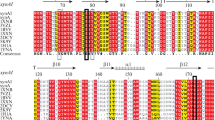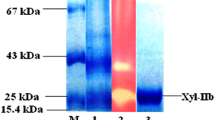Abstract
A xyloglucanase of the GH74 family was identified in the thermophilic fungus strain Myceliophthora thermophila VKPM F-244, and its gene sequence was optimized for cloning and expression in Pichia pastoris. The recombinant xyloglucanase MtXgh74 exhibited the highest activity toward tamarind seed xyloglucan with a K M value of 0.51 ± 0.06 mg/mL. The activities on barley β-glucan and carboxymethylcellulose were about 4 and 2%, respectively, compared to xyloglucan. Maximum xyloglucanase activity was observed at 70–75 °C and pH 6.5. After pre-incubation at 50 °C, pH 6.0 for 3 h, the enzyme retained 100% of its activity. The half-life of MtXgh74 at 60 °C, pH 6.0 was 40 min. In P. pastoris, MtXgh74 was produced in glycosylated form. The enzyme production in a 1 L bioreactor resulted in a yield of 118 U/mL or 5.3 g/L after 51 h fermentation. Kinetic studies of the hydrolysis product formation suggest that MtXgh74 has an endo-processive mode of action. The final products were the standard xyloglucan building blocks XXXG, XXLG, XLXG, and XLLG. Additionally, MtXgh74 hydrolyzed various linkages within the xyloglucan building blocks XXXG, XXLG, and XLXG (except XLLG) producing diverse low molecular weight oligosaccharides which may be identified by MALDI-TOF as XG, XX, XXG/GXX/XGX, XXX, LG, LX/XL, XLX/XXL, LLG, GXXXG, GXLLG, XLLGX. The unique combination of different activities within one enzyme along with its high thermostability and specificity toward xyloglucan makes MtXgh74 a promising candidate enzyme for industrial applications.








Similar content being viewed by others
References
Alahuhta M, Adney WS, Himmel ME, Lunin VV (2013) Structure of Acidothermus cellulolyticus family 74 glycoside hydrolase at 1.82 Å resolution. Acta Crystallogr Sect F Struct Biol Cryst Commun 69(PT 12):1335–1338. doi:10.1107/S1744309113030005
Badhan AK, Chadha BS, Kaur J, Saini HS, Bhat MK (2007) Production of multiple xylanolytic and cellulolytic enzymes by thermophilic fungus Myceliophthora sp. IMI 387099. Bioresour Technol 98:504–510
Beeson WT 4th, Iavarone AT, Hausmann CD, Cate JH, Marletta MA (2011) Extracellular aldonolactonase from Myceliophthora thermophila. Appl Environ Microbiol 77(2):650–656
Berka RM, Schneider P, Golightly EJ, Brown SH, Madden M, Brown KM, Halkier T, Mondorf K, Xu F (1997) Characterization of the gene encoding an extracellular laccase of Myceliophthora thermophila and analysis of the recombinant enzyme expressed in Aspergillus oryzae. Appl Environ Microbiol 63(8):3151–3157
Berka RM, Grigoriev IV, Otillar R, Salamov A, Grimwood J, Reid I, Ishmael N, John T, Darmond C, Moisan MC, Henrissat B, Coutinho PM, Lombard V, Natvig DO, Lindquist E, Schmutz J, Lucas S, Harris P, Powlowski J, Bellemare A, Taylor D, Butler G, de Vries RP, Allijn IE, van den Brink J, Ushinsky S, Storms R, Powell AJ, Paulsen IT, Elbourne LD, Baker SE, Magnuson J, Laboissiere S, Clutterbuck AJ, Martinez D, Wogulis M, de Leon AL, Rey MW, Tsang A (2011) Comparative genomic analysis of the thermophilic biomass-degrading fungi Myceliophthora thermophila and Thielavia terrestris. Nat Biotechnol 29(10):922–927. doi:10.1038/nbt.1976
Bhat KM, Maheshwari R (1987) Sporotrichum thermophile growth, cellulose degradation, and cellulase activity. Appl Environ Microbiol 53:2175–2182
Blanchard V, Gadkari RA, George AVE, Roy S, Gerwig GJ, Leeflang BR, Dighe RR, Boelens R, Kamerling JP (2008) High-level expression of biologically active glycoprotein hormones in Pichia pastoris strains—selection of strain GS115, and not X-33, for the production of biologically active N-glycosylated 15N-labeled phCG. Glycoconj J 25(3):245–257. doi:10.1007/s10719-007-9082-8
Bretthauer RK, Castellino FJ (1999) Glycosylation of Pichia pastoris-derived proteins. Biotechnol Appl Biochem 30:193–200. doi:10.1111/j.1470-8744.1999.tb00770.x
Bukhtojarov FE, Ustinov BB, Salanovich TN, Antonov AI, Gusakov AV, Okunev ON, Sinitsyn AP (2004) Cellulase complex of the fungus Chrysosporium lucknowense: isolation and characterization of endoglucanases and cellobiohydrolases. Biochemistry (Mosc) 69(5):542–551
Bushell ME, Rowe M, Avignone-Rossa CA, Wardell JN (2003) Cyclic fed-batch culture for production of human serum albumin in Pichia pastoris. Biotechnol Bioeng 82(6):678–683
Cereghino JL, Cregg JM (2000) Heterologous protein expression in the methylotrophic yeast Pichia pastoris. FEMS Microbiol Rev 24(1):45–66
Cereghino GPL, Cereghino JL, Ilgen C, Cregg JM (2002) Production of recombinant proteins in fermenter cultures of the yeast Pichia pastoris. Curr Opin Biotechnol 13:329–332
Cregg JM, Cereghino JL, Shi JY, Higgins DR (2000) Recombinant protein expression in Pichia pastoris. Mol Biotechnol 16:23–52
Daly R, Hearn MT (2005) Expression of heterologous proteins in Pichia pastoris: a useful experimental tool in protein engineering and production. J Mol Recognit 18(2):119–138
Dionex (1998) Technical note TN21: optimal settings for pulsed amperometric detection of carbohydrates using the Dionex ED40 electrochemical detector, Sunnyvale
Forouchi E, Gunn DJ (1983) Some effects of metal ions on the estimation of reducing sugars in biological media. Biotechnol Bioeng 25(7):1905–1911
Fry SC, York WS, Albersheim P, Darvill A, Hayashi T, Joseleau JP, Kato Y, Lorences EP, Maclachlan GA, McNeil M, Mort AJ, Reid JSG, Seitz HU, Selvendran RR, Voragen AGJ, White AR (1993) An unambiguous nomenclature for xyloglucan-derived oligosaccharides. Physiol Plant 89:1–3
Gorshkova TA (2007) Plant cell wall as a dynamic system. Nauka, Moscow, 429 p
Grishutin SG, Gusakov AV, Markov AV, Ustinov BB, Semenova MV, Sinitsyn AP (2004) Specific xyloglucanases as a new class of polysaccharide-degrading enzymes. Biochim Biophys Acta 1674:268–281
Gusakov AV, Antonov AI, Ustinov BB (2008) N-Glycosylation in Chrysosporium lucknowense enzymes. Carbohydr Res 343:48–55
Hasslacher M, Schall M, Hayn M, Bona R, Rumbold K, Lückl J, Griengl H, Kohlwein SD, Schwab H (1997) High-level intracellular expression of hydroxynitrile lyase from the tropical rubber tree Hevea brasiliensis in microbial hosts. Protein Expr Purif 11(1):61–71
He Z, Huang Y, Qin Y, Liu Z, Mo D, Cong P, Chen Y (2012) Comparison of alpha-factor preprosequence and a classical mammalian signal peptide for secretion of recombinant xylanase xynB from yeast Pichia pastoris. J Microbiol Biotechnol 22(4):479–483
Heimbach J (2014) Determination of the GRAS status of the addition of tamarind seed polysaccharide to conventional foods as a stabilizer and thickener. Prepared for DSP GOKYO FOOD & CHEMICAL Co., Ltd. Osaka Japan
Ichinose H, Araki Y, Michikawa M, Harazono K, Yaoi K, Karita S, Kaneko S (2012) Characterization of an endo-processive-type xyloglucanase having a β-1,4-glucan-binding module and an endo-type xyloglucanase from Streptomyces avermitilis. Appl Environ Microbiol 78(22):7939–7945
Jahic M, Gustavsson M, Jansen AK, Martinelle M, Enfors SO (2003) Analysis and control of proteolysis of a fusion protein in Pichia pastoris fed-batch processes. J Biotechnol 102(1):45–53
Karnaouri A, Antonopoulou I, Topakas E, Christakopoulos P (2014) Genomic insights into the fungal lignocellulolytic system of Myceliophthora thermophila. Front Microbiol 5:281. doi:10.3389/fmicb.2014.00281
Kozlov DG, Yagudin TA (2008) Antibody fragments may be incorrectly processed in the yeast Pichia pastoris. Biotechnol Lett 30:1661–1663
Krestyanova IN, Sakhibgaraeva LF, Berezina OV, Rykov SV, Zavyalov AV, Zverlov VV, Yarotsky SV (2016) Characteristics of fungal strains producing thermostable xyloglucanases from the Russian National Collection of Industrial Microorganisms. Mol Genet Microbiol Virol 31(3):149–155
Laemmli UK (1970) Cleavage of structural proteins during the assembly of the head of bacteriophage T4. Nature 227:680–685
Maier SK, Bashkueva K, Rösli C, Skerra A, Kuster B (2014) PAS-cal: a repetitive peptide sequence calibration standard for MALDI mass spectrometry. Proteomics 14(21–22):2427–2431. doi:10.1002/pmic.201400199
Matsuzawa T, Saito Y, Yaoi K (2014) Key amino acid residues for the endo-processive activity of GH74 xyloglucanase. FEBS Lett 588(9):1731–1738. doi:10.1016/j.febslet.2014.03.023
Morton J (1987) Tamarind. p. 115–121. In: Fruits of warm climates. Julia F. Morton, Miami, FL
Munusamy K, Somani RS, Bajaj HC (2011) Tamarind seeds carbon: preparation and methane uptake. Bioresources 6(1):537–551
Ramchuran SO, Mateus B, Holst O, Karlsson EN (2005) The methylotrophic yeast Pichia pastoris as a host for the expression and production of thermostable xylanase from the bacterium Rhodothermus marinus. FEMS Yeast Res 5(9):839–850
Rosgaard L, Pedersen S, Cherry JR, Harris P, Meyer AS (2006) Efficiency of new fungal cellulase systems in boosting enzymatic degradation of barley straw lignocellulose. Biotechnol Prog 22:493–498
Roy SK, Dey SK, Raha SK, Chakrabarty SL (1990) Purification and properties of an extracellular endoglucanase from Myceliophthora thermophila D-14 (ATCC 48104). J Gen Microbiol 136:1967–1971
Schwarz WH, Bronnenmeier K, Gräbnitz F, Staudenbauer WL (1987) Activity staining of cellulases in polyacrylamide gels containing mixed linkage beta-glucans. Anal Biochem 164:72–77
Sinegani AAS, Emtiazi G (2006) The relative effects of some elements on the DNS method in cellulase assay. J Appl Sci Environ Mgt 10(3):93–96
Trimble RB, Lubowski C, Hauer CR III, Stack R, McNaughton L, Gemmill TR, Kumar SA (2004) Characterization of N- and O-linked glycosylation of recombinant human bile salt-stimulated lipase secreted by Pichia pastoris. Glycobiology 14(3):265–274
Vincken J-P, Beldman G, Voragen AGJ (1997) Substrate specificity of endoglucanases: what determines xyloglucanase activity? Carbohydr Res 298:299–310
Visser H, Joosten V, Punt PJ, Gusakov AV, Olson PT, Joosten R, Bartels J, Visser J, Sinitsyn AP, Emalfarb M, Verdoes JC, Wery J (2011) Development of a mature fungal technology and production platform for industrial enzymes based on a Myceliophthora thermophila isolate, previously known as Chrysosporium lucknowense C1. Ind Biotechnol 7(3):214–223. doi:10.1089/ind.2011.7.214
Werten MW, van den Bosch TJ, Wind RD, Mooibroek H, de Wolf FA (1999) High-yield secretion of recombinant gelatins by Pichia pastoris. Yeast 15(11):1087–1096
Wood TM, Bhat KM (1988) Methods for measuring cellulase activities. Method Enzymol 160:87–112
Yaoi K, Mitsuishi Y (2002) Purification, characterization, cloning, and expression of a novel xyloglucan-specific glycosidase, oligoxyloglucan reducing end-specific cellobiohydrolase. J Biol Chem 277(50):48276–48281. doi:10.1074/jbc.M208443200
Yaoi K, Kondo H, Noro N, Suzuki M, Tsuda S, Mitsuishi Y (2004) Tandem repeat of a seven-bladed beta-propeller domain in oligoxyloglucan reducing-end-specific cellobiohydrolase. Structure 12:1209–1217
Yaoi K, Kondo H, Hiyoshi A, Noro N, Sugimoto H, Tsuda S, Miyazaki K (2009) The crystal structure of a xyloglucan-specific endo-beta-1,4-glucanase from Geotrichum sp. M128 xyloglucanase reveals a key amino acid residue for substrate specificity. FEBS J 276(18):5094–5100. doi:10.1111/j.1742-4658.2009.07205.x
Author information
Authors and Affiliations
Corresponding author
Ethics declarations
The article does not contain any studies with human participants or animals performed by any of the authors.
Funding
This study was funded by the Ministry of Education and Science of the Russian Federation (grant number 14.628.21.0001, identification number RFMEFI62814X0001) and the German Federal Ministry of Education and Research (grant number FKZ: 031A556).
Conflict of interest
The authors declare that they have no conflict of interest.
Electronic supplementary material
ESM 1
(PDF 646 kb)
Rights and permissions
About this article
Cite this article
Berezina, O.V., Herlet, J., Rykov, S.V. et al. Thermostable multifunctional GH74 xyloglucanase from Myceliophthora thermophila: high-level expression in Pichia pastoris and characterization of the recombinant protein. Appl Microbiol Biotechnol 101, 5653–5666 (2017). https://doi.org/10.1007/s00253-017-8297-2
Received:
Revised:
Accepted:
Published:
Issue Date:
DOI: https://doi.org/10.1007/s00253-017-8297-2




